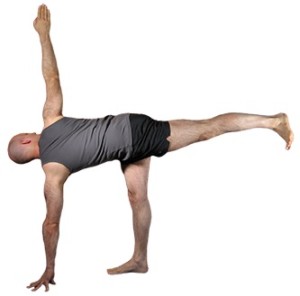
After taking all the necessary precautions for yoga and scoliosis into consideration and getting approval and recommendations from the practitioner treating you, if you have scoliosis and would like to establish a scoliosis yoga program, here are some poses to AVOID or take greater care when performing.
Back-Bending
Bending a scoliotic spine backwards will reduce the normal front to back thoracic shape (kyphosis). This “normal” part of the spinal shape works to limit scoliosis progression. You want to encourage this shape, NOT do anything to reduce it! By the way… back bend positions will not effectively lessen the rib arch. There really is nothing that can… surgery with rib shaving is the only method… and that is very invasive! Back-bending postures flatten the thoracic spine which can destabilize the area and can worsen the scoliosis.
Cobra / Bhujangasana or Naga-asana

Half Moon / Ardha Chandrasana

Bow pose / Dhanurasana

Camel / Ustrasana

Wheel / Chakrasana / Urdhva Dhanurasana

Locust / Salabhasana

King of the dance / Nataraja-asana

Scorpion / Vrischikasana

Sun salutation
The back-bending in Cobra or Upward Dog is a problem so avoid these parts in your scoliosis yoga program. A baby cobra would be a better option.
Twisting the Torso Against the Pelvis
Unless you are certain it will not aggravate the rib arching, avoid twisting the torso against the pelvis. The rib arch, is increased as it rotates backwards into the existing curvature, regardless of whether the rotation is to the left or right side. There are types of scoliosis that CAN include these types of twists in their yoga for scoliosis program BUT, only to one side! Talk to your practitioner about these poses before including it in a scoliosis yoga program. Do it to the wrong side, or in the presence of a compensatory curve elsewhere in the spine and you are asking for trouble!
Spinal Twist / Ardha Matsyendrasana

People with scoliosis should absolutely avoid the Spinal Twist. Some types of scoliosis have up to three or four curves of the spine from the neck, middle back and rib cage, and lumbar spine into the pelvis. These can be increased by twisting one section against another at the expense of a third or fourth area of scoliosis in the same spine. Even if it is done on either side, it is still counterproductive.
Triangle / Trikonasana

Avoided because the shoulder girdle is twisted against the pelvis and the middle section must follow after the more comfortable side.
Seated Twist / Bharadvajasana

Sage Twist / Marichyasana

Bending the Rib Cage
Bending the rib cage backwards, forwards or sideways should all be avoided. Trying to open up the main scoliotic curve between the thoracic and lumbar spine may improve the major thoracic curve BUT at the expense of any curvatures above or below that curve. How will you know that is happening? Would you be able to notice that the adjacent regions of your scoliosis were worsening? Maybe… maybe not!
Side bend / Ardha Chandrasana

A scoliosis patient performing this exercise to both sides would exercise into the existing curve and increase it. It is not recommended even if also performed in the opposite direction. This type of pose must be done only to one side, and if it is effective at unlocking the spine, MUST be accompanied by neuromuscular retraining!
Other Poses to Avoid:
Shoulder stand / Sarvangasana

In the shoulder stand pose the head is bent sharply forward. This over stretches the neck muscles. It will also promote cervical kyphosis (a reversing of the normal shape of the neck). The whole body weight is on the shoulders, and could greatly increase a rib arch formation. An important part of any scoliosis yoga correction program is to work with improvement of the normal curvatures of the neck and low back. Shoulder stand will work AGAINST the establishment of normal spinal contours! Avoid it!
The Plow / Halasana

Effect is similar to the shoulder stand. Will work against the normal neck curve.
Headstand

A scoliotic spine is inherently weak and unstable. Turn it upside down and push it into the skull and you risk destabilizing it further. The upper cervical (top part of the neck) is often problematic due to ligament stress from the scoliosis. Headstand will place undue pressure on these weakened ligaments. It is better to perform isometric strengthening to stabilize the weakened area.